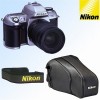Nikon F80QD User Manual - Page 10
Mount Lens
 |
UPC - 718122227020
View all Nikon F80QD manuals
Add to My Manuals
Save this manual to your list of manuals |
Page 10 highlights
BASIC OPERATION Mount Lens 2 Turn the power switch off and mount the lens to the camera body. 2.1 Check the lens type. Check points Use a D- or G-type AF Nikkor lens to utilise all of this camera's functions. (See page 34 for Lens Compatibility.) Make sure to turn the power switch off when attaching/detaching the lens. When attaching the lens, take care not to press the lens release button. Avoid direct sunlight when attaching/detaching the lens. 2.3 With CPU Nikkor lens with aperture ring (other than Gtype), set the lens aperture to its minimum and lock. CPU contacts of CPU lens Å CPU Nikkor lens other than G-type Í G-type Nikkor lens Å CPU Nikkor lens other than G-type (Illustration is D-type Nikkor lens), with aperture ring Í G-type Nikkor lens, without aperture ring 2.2 Turn the power switch off and mount the lens to the camera body. 2.4 22 22 • When CPU Nikkor lens other than G-type is not set to its minimum aperture setting (largest f-number) and the power switch is turned on, ƒEE blinks in the LCD panel and viewfinder and the shutter cannot be released. • The G-type Nikkor lens has no aperture ring; aperture should be selected from camera body. Unlike other CPU Nikkor lens, aperture does not need to be set to minimum. Detaching the lens. 35 28 28 50 m ft 70 85 105 • Position lens in the camera's bayonet mount so that the mounting indexes on lens and camera body are aligned, then twist lens counterclockwise until it locks into place. (Be sure not to touch the lens release button.) • When the lens is not attached or when a non-CPU Nikkor lens is attached and the power switch is turned on, ƒ-- blinks in the LCD panel and viewfinder, and the shutter cannot be released. See page 34 for a nonCPU lens. 18 • Push and hold the lens release button, then turn the lens clockwise. When camera is left unattended without lens When you leave the camera unattended without a lens attached, be sure to attach the supplied body cap (page 3), or optional body cap BF-1A. (BF-1 body cap cannot be used.) 19















